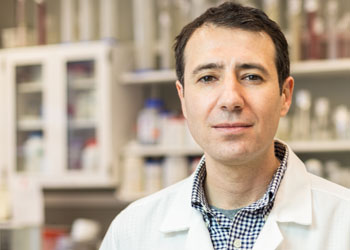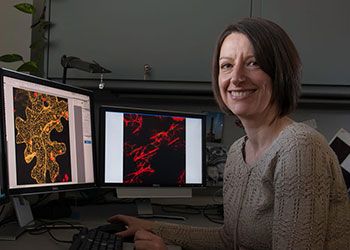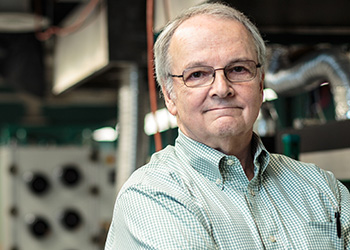More Than Meets the Eye
Erik Shapiro uses creative approaches to unlock the mysteries of deadly diseases
More Than Meets the Eye
Erik Shapiro uses creative approaches to unlock the mysteries of deadly diseases
March 26, 2016Creativity. Beauty.
These are the words radiology faculty member Erik Shapiro uses to describe his research.
By using one of the most advanced imaging systems in the world—the 7 Tesla, three times more powerful than a standard MRI—Shapiro and his team are unlocking the mysteries of diseases like cancer, liver disease and neurodegenerative disease.
And Shapiro loves his job.
The path forward
A New Jersey native, Shapiro was recruited to Michigan State in 2012 from Yale’s radiology department. He quickly realized MSU was the right place for him to be.
“After spending six years at Yale, I came to Michigan State for its leadership and growth opportunities,” Shapiro said. “I knew this was the place where my research could best be achieved and it’s awesome … I couldn’t be happier here.”
Shapiro explains biomedical engineering as an approach to studying medicine through a hybrid of disciplines involving mathematical approaches to biological questions. Shapiro and his team are applying biomedical imaging and data analysis to regenerative medicine.
For example, using the 7 Tesla MRI along with nanomaterials, researchers can potentially see small populations of cancer cells before standard detection, to enable cell-based therapies.
“I like to be surprised by things,” Shapiro admitted. “And I like seeing the successes of my students. The joy of the job includes the science, yes, but maybe even more so is watching students grow and discover, fail and succeed.”
Currently, one of Shapiro’s postdoctoral fellows is independently developing nanoparticles that will create an MRI contrast and release medication to specific enzymes, like those only found in cancer.
A major breakthrough could be just around the corner, and Shapiro admits seeing students succeed in these ways is a great source of joy.
But along with this joy comes challenges.
Support empowers the future
A barrier to creating breakthroughs is placing top graduate students in Shapiro’s lab—earnest requests to join the team are common.
“We have created this pipeline among departments, so for example, chemical engineers who know how to make nanomaterials want to learn imaging,” Shapiro said. “To support a really talented graduate student or postdoctoral fellow, we need to provide a stipend, cover tuition costs and offer research support.”
Essentially, the group could accomplish more, faster with private support.
Shapiro’s presence at Michigan State proves: the university has the people and ideas to solve the world’s biggest problems. Private support is the key that unlocks research accomplishment by attracting the best and brightest faculty and graduate students to MSU.
Learn more about supporting the College of Osteopathic Medicine.




